by Joe Domaleski | Jan 8, 2024 | Blog, Business, Columnists, Community, News Center, Opinion
Let me start out this article by getting to the main point — 2024 is going to be a year of change and adjustment for businesses of all sizes, but particularly small, local businesses.
We all had to adjust to the changes brought on by COVID a few years ago. I think most of us thought things would go back to “normal” after that, but they haven’t. Change is part of life, but it seems change is happening at an accelerating rate.
Here in our local community, I see how rapid change has really impacted some folks in a very positive way, but it’s really left others in the dust. As a 25-year resident of the area (and my wife a lifelong resident), I’m probably somewhere in the middle of those two extremes. Some areas of our community are not even recognizable (which isn’t necessarily bad) from what they looked like just a few years ago, while other areas haven’t changed in 100 years.
My company was started in 2003 because I wanted to make some changes in my life. Change can be uncomfortable, but it also presents opportunities, as it has for me and my family. It’s been my experience that small businesses have the ability to pivot and react to change quicker than larger organizations. That doesn’t mean it’s simple, but it’s easier to change a 10-person company than it is a 10,000-person organization.
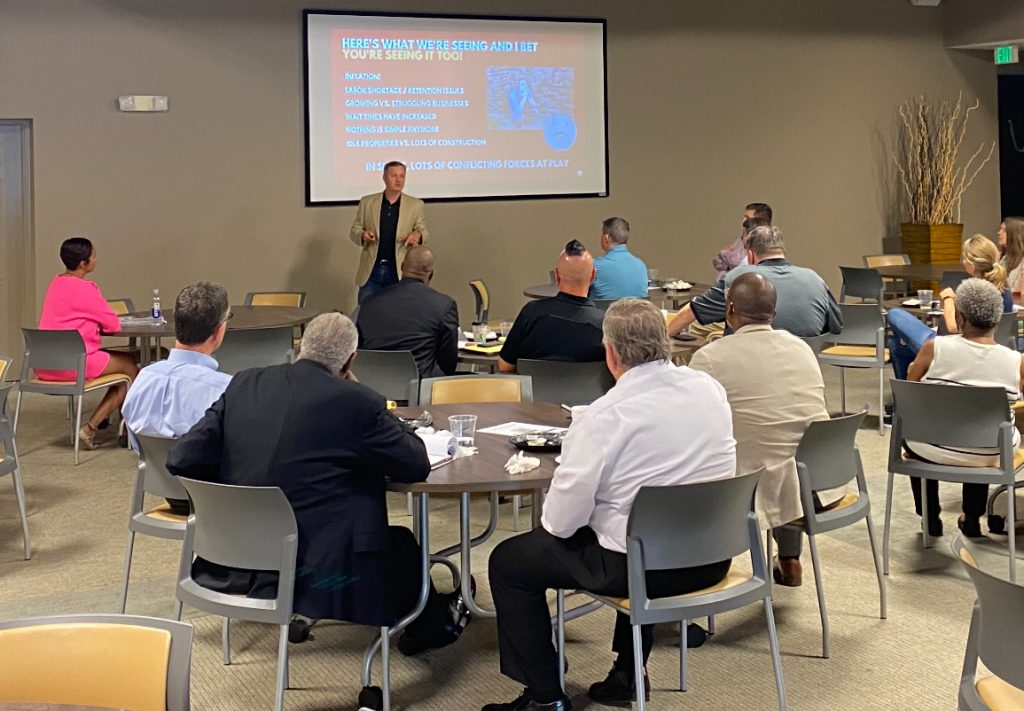
The author speaking to the Fayette County Chamber of Commerce in 2023 about business trends during the business outlook summit. Photo/Joe Domaleski
Like most small business owners, I’m generally grounded in the present while looking ahead towards the future. I’m often asked what I see as future trends, but my answers normally come out as informal dialogue with colleagues and other community leaders in an informal setting.
In this article, I’m going to put my “predictions” into writing. We can see how well I nailed it at the end of the year. Most of the news and economic predictions are provided at a national or state level. I’m going to focus on change as it applies to our small, local businesses like mine.
1.Artificial Intelligence (AI) will become an important part of small business operations.
Last year, ChatGPT showed up out of nowhere and not only caught the tech giants off guard, but it also surprised most of us. Seemingly overnight, we all had access to a free tool that we could use to generate content and answer questions using regular language. We’ve had access to other forms of AI for several years now, but this ability for AI to create things is new (aka generative AI).
Most organizations, mine included, tried out some things using AI and I’ve written about that previously. This year, AI is going be less of a toy and more of an important tool used to increase productivity, reduce costs, and speed up time-to-benefit. People who learn how to use it will become more productive and valuable. Businesses (and employees) who don’t catch on or refuse to use it will get left behind.
For those old enough to remember, this is very similar to the desktop computer (PC) revolution in the 80s. Prior to the PC, mainframe computers were in big rooms operated by specially trained staff. Once the PC came out, everyone had one on their desktop. It’s that way with AI right now. Wading through the hype to figure out how to safely and securely implement AI into key business operations is going to be a high priority for most organizations this year.
According to IBM in the recently published 5 Trends for 2024,
“People who use AI will replace people who don’t”.
2. Creativity will become the number one job skill for businesses of all sizes, particularly small businesses.
Matt Candy, global managing partner in generative AI at IBM, has said, “the jobs of the future will be filled by those who can work with AI using language and creative thinking. AI is ‘learning to talk our language’”. Yes, I think AI is a big enough deal that my top two trends deal with it. Whereas my first trend was about the technology itself, this one is about people.
Creative people will find novel ways to innovate, ideate, and generate things using AI technology as a tool, much like an artist uses a palette and paintbrush. People who just crank out AI content for marketing materials, blogs, social media posts, and other purposes are actually going to hurt their organizations.
I don’t know about you, but I’m already tired of AI-generated advertisements, photo enhancements, and bland robot-written content. In this new age of robotic content, people are going to crave human-generated creations. As tempting as it is to fill up a blog with ChatGPT written content, don’t. AI detection systems are freely available and Google favors people-first content.
3. Customer service will continue to be a challenge for most businesses.
No matter what kind of business you have, some customers (typically older ones) expect direct human interaction via phone calls, meetings, and in-person service counters. Providing in-person service is not as easy as it used to be. Ask any business leader and one of their top challenges is workforce development, whether you’re trying to hire servers or engineers.
Not only is it hard to attract qualified labor, but it’s very difficult to keep up with wages. I’ve seen our own payroll costs double in the last three years, mostly driven by inflation. This is why many businesses opt for automated customer service solutions such as online help, chatbots, and order-entry kiosks. Younger people seem to be more comfortable with these types of solutions and, in many cases, would rather have a self-service option than have to speak to someone on the phone.
If you’re a business leader, it’s not either-or, it’s both — you have to be able to provide both “live customer service” and automated “self-service”. Speaking from experience, we love interacting with our customers, but it can be challenging because everyone wants to interact with us in a different way — email, web portal, text message, phone call, or appointment. This stratification of customer service models is especially true in our community which tends to skew towards an older, more traditional population. As a middle-aged person, I can operate comfortably in both models of customer service, but it doesn’t mean that it’s easy or cost-effective.
4. Agile business models will work their way into many industries.
Armed with better data and automated processes, businesses will be more agile in responding to changing market conditions. Slow-moving organizations (and people) will continue to fall behind. Leaders will be challenged with the need to be responsive, but not overreact.
As a society, we are increasingly becoming bored and impatient. We want what we want, when we want it. Most of us have a smartphone that enables us to get immediate gratification for reservations, information lookups, communication, and product ordering. Technology will enable quicker feedback and execution of business strategies.
It used to be that only large businesses had access to predictive models to associate something like ad spend to customer acquisition. Those types of analytics are now available to the smallest of businesses. In particular, AI is ruthlessly effective at spotting patterns and trends in data.
I think most businesses are already implementing agile business models and it’s my hope that the government catches up. Here in our community, we are fortunate in that most of our municipalities and governmental organizations are trying to find ways to be more responsive to the needs of its citizens. As long as change is tempered with the desire for improvement, I think being agile is a good thing for any organization.
5. A return to profitability will become the number one goal for most businesses.
At first blush, that seems self-evident. I don’t know of a single business or non-profit that wants to run at a loss. On the other hand, I know many business leaders, especially local ones, who put the needs of their people above the financial needs of the organization during the “survival” mode of the pandemic.
I’m proud of our local business and community leaders who came together during those times. I personally enjoyed participating in some of the “support local” business initiatives of the times. We live in a new era. After the bumpy ride of the pandemic, businesses began to recalibrate by hiring new people and implementing new technologies.
This, among other factors like supply chain disruptions and the current wage-price spiral, has contributed to inflation. Inflation tends to cool off the economy. While some industries thrive no matter what’s going on with inflation, it’s been my observation here locally that it’s caused a cooling off in the demand for many of the products and services from our B2C (business-to-consumer, retail) and B2B (business-to-business) small businesses.
In short, people are eating at home more and spending less money. You don’t have to be an economist to see the impact of inflation here in our community. Returning to profitability is important so that businesses can cover increased expenses (labor, materials, operating costs) and maintain operational viability.
So there you have it, my top five small business trends for 2024. Obviously, there’s a lot more going on in our community and the world at large than what I’ve listed. Change is not easy, but the rapid and thoughtful adoption of AI has the potential to really help businesses, particularly small businesses, grow to new levels of success. This year will see the creative, human-centric use of technology usher in a new era of agility and profitability, just as the PC did for those of us back in the ’80s. The journey will be bumpy. Organizations that figure out how to thrive in this environment will come out on top. Others who are slow to learn and adapt will get left behind.
Yes, jobs will be lost or reclassified, but new jobs will also be created. That’s not a bad thing, although growth sometimes hurts. The web and internet didn’t exist when I was in college, yet for the past twenty years, I’ve been running a marketing agency that got its start doing web design. There will be new jobs and business opportunities in the next few years that haven’t even been thought of today.
Being a leader is never easy, and making decisions that may negatively impact people can be tough. Focusing on the greater good sometimes necessitates making a change that “rips the band-aid off” so that the pain is temporary. I don’t know what kind of changes you are considering for this new year, but whatever they may be, I wish you much success and know that I’m out there with you. A friend of mine recently shared the following quote with me:
“As a leader, you do what is right, not what is convenient and comfortable.”
[Joe Domaleski, a Fayette County resident for 25 years, is the owner of Country Fried Creative – an award-winning digital marketing agency located in Peachtree City. His company was the Fayette Chamber’s 2021 Small Business of the Year. Joe is a husband, father of three grown children, and proud Army veteran. He has an MBA from Georgia State University and enjoys sharing his perspectives drawing from thirty years of business leadership experience. Sign up for the Country Fried Creative newsletter to get marketing and business articles directly in your inbox. ]
by Joe Domaleski | Jan 1, 2024 | Blog, Business, Columnists, Community, Front Page, News Center, Opinion
Welcome to the start of a new year. It’s a chance to hit the reset button and start the year off with new goals and objectives. There are plenty of articles out there about setting general goals and resolutions, so we won’t cover that here. What I do want to focus on is one specific goal that I have and that is to spend more time learning and honing my own skills. Most of the readers of this newspaper tend to be middle-aged (like me) and older, so learning is even more important for us than younger people. We’ll come back to the reason I make that statement in a little bit.
For now, I’ve decided to adopt the personal theme of “New Year, New Skills.” This theme is one that applies to me as both an individual and as a business leader. In this post, I’ll delve into why continuous learning is particularly crucial for us in middle age and beyond, and how it impacts innovation and the vitality of our businesses. First, let me share a bit of personal history to make this more relevant.
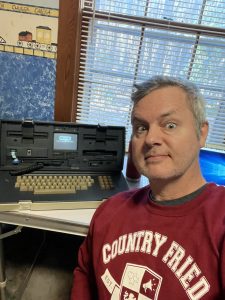
The author with a vintage portable computer from 1982, the Osborne I (still works) with 64K RAM, Z80 processor, two 5 1/4″ floppy disk drives, and a 300 baud modem. Photo/Joe Domaleski
Ever since the dawn of the desktop PC (personal computer) in 1980, I’ve had a fascination with technology. In high school, our class was one of the first to study computer programming (thank you Coach Horsley). My father taught data processing at DeKalb Community College, now Georgia State University Perimeter College. Dad bought one of the first portable computers, the Osborne-I “suitcase” computer which I had access to at home to further enhance my learning (see adjacent picture). In college, I decided to study Computer Science at University of North Georgia (formerly North Georgia College). Because Computer Science was in the Department of Mathematics, I ended up getting a dual degree in Math/Computer Science. Not only did I study computer programming, algorithms, and compiler construction, I also studied a lot of math including numerical analysis, calculus, statistics, linear algebra, and matrix math. Calculating dot products on matrices is not something I ever thought I’d see later in life, but I was wrong.
After my stint in the Army, I entered graduate school to work on my MBA at Georgia State University. One class I particularly enjoyed was decision sciences. In the class we used computers (mostly Lotus 123 spreadsheets) and statistics to solve business problems and perform optimization analysis and forecasting. Often times I decided to write my own programs to solve these problems. After class one day, I started talking to one of my professors who mentioned something called a “neural network” as an emerging concept for computer aided decision making. Knowing that I had a background in computer science he asked me to collaborate with him on creating a rudimentary neural network (written in the C programming language) to do financial market graph pattern matching. The math behind neural networks was and still is matrix math (just 4 years earlier I thought I’d never see a matrix again). We did some good work and I was invited to apply to pursue further studies as a PhD candidate. I decided not to pursue a PhD, even though I had been accepted into the program, in order to start a family and make money.
Fast forward 30 years later and I want to be student again. Don’t get me wrong, I’ve learned a lot by being a consultant for the first 10 years of my career and even more by being a small business owner for the next 20 years. But something has rekindled my original interests in math/computer science – yes, the re-emergence of Artificial Intelligence. Faster computers and 30 years worth of Internet data has finally brought AI out of the lab and onto our phones. Most people don’t give AI a second thought, as it has crept into your life by tagging your pictures, planning your routes, suggesting what movies to watch, recommending music you might like, and serving up a steady stream of social media (and ads) on your phone. Some people are blindly using it to generate bland written content and sterile images (please don’t do that, we can tell the difference). Others are using it to good effect by helping them almost like a personal assistant. But this isn’t a story about AI, it’s a story about learning and why it’s become important to me again.
As a middle-aged person, it’s not lost on me that my career has peaked. No, I’m not retiring but as I’ve mentioned in previous articles, the story isn’t about me anymore – I’ve done the things I’ve wanted to do and as the “old guy” it’s my job to mentor and support younger people to help them succeed such as my adult children, the staff at my company, and other aspiring leaders in our community. Yet, I’ve been toying around the idea of a “Second Act”. How can I keep my mind sharp, stay relevant, and pursue earlier interests that I put on hold? Learning!
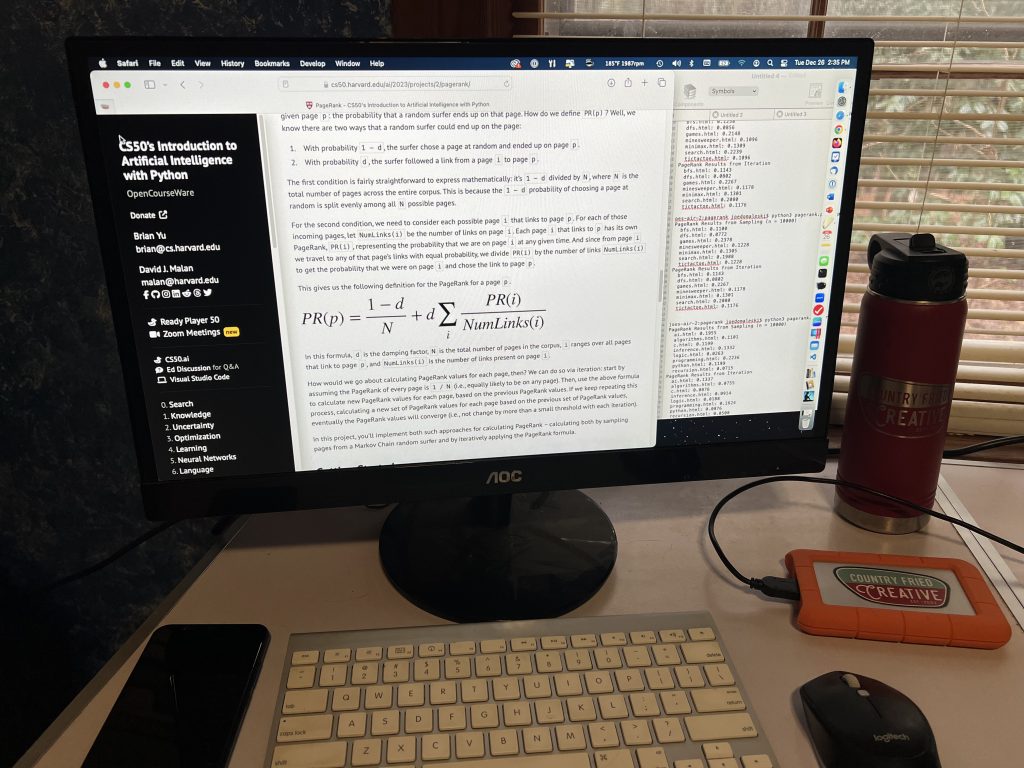
In our home office keeping my skills sharp by working on a Google PageRank project for a class in developing AI applications using Python programming. Photo/Joe Domaleski
In a recent article for Scientific American (June 2023), Dr. Rachel Wu and Dr. Jessica Church Lang have written a compelling article entitled “To Stay Sharp as You Age, Learn New Skills.” It’s worth a read. There are countless other articles you can read about the benefits of learning, participating in hobbies, doing puzzles, and other “brain activities” to help us stay sharp in the second half of our lives. Young people are generally better at learning than older folks. For many, learning tends to peak by age 40. Other than some professions having mandatory continuing education requirements, most working professionals over 40 tend to stop formal learning. Over 50, which includes me, many tend to not want to learn anything because we’re set in our ways. That’s brittle thinking and leads to obsolescence. I think it’s possible to leverage “older knowledge” with newer learning and skills. In my case, what’s old is new again in the form of AI which is powered by concepts I learned over 30 years ago – matrix math and neural networks!
So, what are some of the benefits of learning new things?
Enhanced Cognitive Function: This is just a fancy way of saying that learning new skills stimulates the brain, helping to keep you sharp. As was mentioned in the Scientific American article above, this can be particularly beneficial in delaying or reducing the risk of cognitive decline associated with aging. Let’s start learning right now by looking up the word “neuroplasticity.” Consider how that relates to the learning experience.
Improved Memory: Engaging in learning activities has been shown to improve memory. When we learn new things, we exercise our “memory muscle”, which can help in retaining information better and for longer periods. By the way, have you seen my car keys?
Increased Emotional Well-being: Learning new skills can boost self-esteem and confidence. It provides a sense of accomplishment and can be a source of joy and fulfillment. I know one recent innovation of learning is to “game-ify” the process where certain learning goals attainments are rewarded by earning points and unlocking achievements, just as you would in a game.
Social Engagement: Often, learning involves interacting with others, whether it’s in a class setting or online forum. This social aspect can be vital for older adults, helping to combat loneliness and build a sense of community. This was impacted a few years ago by the COVID-19 pandemic, but it also lead to the development of more online community learning. I personally like a mix of both online and in-person learning.
Keeping Up with Technological Advances: In a world where technology is also changing, learning new tech skills keeps us connected and able to engage with modern tools, from smartphones to the latest software. For example, I originally learned spreadsheets with SuperCalc, followed by Lotus 123, then Microsoft Excel, and now Google Sheets. The concepts are the same, but the tools have evolved. Pro tip for some of my peers, stop using Microsoft Powerpoint and consider using Canva! My staff helped me learn about that one.
Physical Health Benefits: Some learning activities, especially those that involve physical activity like dance classes or yoga, can have direct physical health benefits, aiding in maintaining flexibility, balance, and overall fitness. Learning doesn’t just have to be a brain activity. Last year I took up ballroom dancing so that I could dance at my daughter Alex’s wedding. I’m still not that good at it, but it was a great learning experience.
Adaptability to Change: Learning new skills helps us (particularly older adults) stay adaptable in a changing world. This adaptability is important not just for personal growth but also for understanding and relating to younger generations. I am constantly learning things from younger people and strive to keep an open mind about new ways of doing things.
Career Enhancement: For those still in the workforce, learning new skills can lead to career advancement or even a change in career paths. Learning helps keep people competitive in the job market. Ask an employer (including me) what the number one challenge is and we’ll tell you it’s finding a qualified workforce with the skills to do today’s work and a willingness to continuously learn in order to be prepared for tomorrow’s work. Back to AI – if you are not learning about how to use it (both its strengths and weaknesses) you will be left behind in the workforce.
Intellectual Curiosity and Lifelong Learning: Fostering a culture of intellectual curiosity can lead to a more fulfilling, enriched life. It keeps the mind active and engaged, crucial for maintaining mental agility. I enjoy learning new things, solving problems, and staying relevant. Learning helps you to be a more interesting person at parties and other social gatherings.
Creativity and Innovation: Learning activities expose us to new ideas and perspectives, which can ignite our own creative processes that lead to innovation. Creativity and innovation are two of the most important success factors for a business, especially in today’s algorithm-driven world. Indeed, one reason I have renewed my interest in AI is to peer back into the “black box” to see what’s going on. Most people don’t bother fact-checking or understanding the how/why of things. I think that’s a mistake.
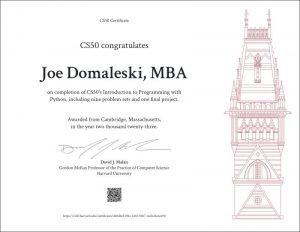
The author’s Harvard University CS50P – Programming in Python certificate of completion. Photo/Joe Domaleski
So back to me and my goals for the new year. What have I personally been doing to learn and improve my own skills? One of the ways has been to write this weekly column. I’ve always enjoyed writing, but haven’t had much of an opportunity until recently. One of the best ways to get better at something is to do it. I’m very appreciative of the support and feedback about this column that many of you have given me in person and on social media. Another way that I’m trying to be more deliberate about learning, is to take formal online classes. I recently completed a Harvard University CS50 online class about Python (it’s not a snake, it’s a modern computer programming language used in AI and data science) and am enrolled in a class right now where we’re actually developing AI applications. I’m looking forward to applying those skills with our marketing clients. At work, we’ve been fostering a culture of learning and skills development by encouraging staff to obtain industry certifications. Certification programs help encourage and validate skills development. Every team member participated, including me.
As I start this “New Year, New Skills” endeavor, I invite you, my readers, to join me. Let’s challenge the stereotype that learning is just for the young. Whether it’s rekindling an old interest, picking up a new hobby, or enhancing our professional skills, let’s demonstrate that age is just a number when it comes to learning. Not only will you be setting a good example for others, but the young people in your life will be glad you’re making an effort to stay relevant and up-to-date. Let’s make this year not only about achieving our business goals but also about personal growth and intellectual enrichment. Remember, the journey of learning never ends, and it’s never too late to start. You may find out, like I did with matrix math and neural networks, that your original knowledge is still valid, it just needs an update to be relevant in today’s world.
[Joe Domaleski, a Fayette County resident for 25 years, is the owner of Country Fried Creative – an award-winning digital marketing agency located in Peachtree City. His company was the Fayette Chamber’s 2021 Small Business of the Year. Joe is a husband, father of three grown children, and proud Army veteran. He has an MBA from Georgia State University and enjoys sharing his perspectives drawing from thirty years of business leadership experience. Sign up for the Country Fried Creative newsletter to get marketing and business articles directly in your inbox. ]
by Joe Domaleski | Dec 25, 2023 | Blog, Business, Columnists, Community, News Center, Opinion
Happy Holidays and hello, winter. It’s Christmas for some, Hanukkah, Kwanzaa, and Winter Solstice for others. No matter what you celebrate, it’s customary to gather together with our families as we wind down the year. This time of year is not only a time of celebration, but for me personally, it’s usually a time of reflection and planning. For some reason, we’re either around a lot of people during the holidays attending parties, dinners, and gatherings, or it’s just my wife, Mary Catherine, and me in a quiet house. I love being with family, but I also enjoy periods of solitude.
During periods of quiet, I normally try to work on some things around the house and get caught up on my personal “to do” list. What I look forward to the most, however, is some quiet time to just sit and think. Years ago, I learned how to be more deliberate about thinking after reading a book entitled “Thinking for a Change” by John C. Maxwell.
“Your thinking, more than anything else, shapes the way you live. It’s really true that if you change your thinking, you can change your life.”
– John C. Maxwell
Maxwell, perhaps best known for his books “The 21 Irrefutable Laws of Leadership” and “Developing the Leader Within You,” is one of my favorite leadership authors. Twenty years ago (the same year I started my business), he actually came to Fayette County and did a national broadcast originating from the newly established New Hope Church South Campus. Perhaps some of you reading this were there that day, it was a huge crowd.

Autographed copy of Thinking for a Change by John C. Maxwell dated 3-28-2003. Photo/Joe Domaleski
While I was there at the Maxwell event, I picked up one of his lesser-known titles, “Thinking for a Change.” The message was simple, but it quickly became one of my favorites of his many books. His emphasis on the power and potential of “just thinking” really inspired me to be more deliberate about how I approached thought.
In the book, Maxwell makes the case that all actions and endeavors begin and end with thought. He maintains that there are different types of thinking skills and outlines each one of them in the book. Here’s a quick summary of those key skills and what they mean to me personally:
Big-Picture Thinking: Seeing beyond the day-to-day to understand the broader scope and future direction of my business and my life. I probably struggle with this more than any other type of thinking. It’s hard to think about the big picture when you’re drowning in the details of “here and now.”
Focused Thinking: Applying concentration and focus on key goals and challenges in order to make decisions and solve problems. I actually enjoy this type of thinking the most, but I have to be deliberate about tuning out distractions from emails, messages, and other non-urgent things that sometimes feel urgent.
Creative Thinking: Coming up with new ideas to drive innovation. Creativity allows individuals and organizations to develop new ideas, products, and services, which can lead to breakthroughs, excitement, and forward progress. This is what my company is best known for, and it’s actually part of our company name – Country Fried Creative. For me personally, the challenge isn’t the creativity part (because I have a great creative team) but it’s the application of that creativity to specific situations.
Realistic Thinking: Assessing situations objectively with facts, data, and experience. Oftentimes creativity is tempered with reality. Brainstorming shouldn’t be constrained by reality, but reality definitely comes into play before implementing ideas. As a business owner, I have to assess the feasibility and market potential of our creative ideas. Realistic thinking gives us the proper context for doing that.
Strategic Thinking: Planning effectively to achieve goals and objectives. This is different from big-picture thinking, which often isn’t constrained by goals and objectives. Strategic thinking considers various scenarios and paths. I often consider the best case, worst case, and probable case when it comes to strategic thinking. Risk vs. reward comes into play when considering strategic thinking.
Possibility Thinking: Empowers people to look beyond apparent constraints, envisioning what could be achieved. For me, this is the classic “Can Do” thinking where anything is possible. It’s all about being a leader of hope.
Reflective Thinking: Taking time to ponder and learn from past experiences. I do this a lot, perhaps too much. While it’s important to consider the past, it’s even more important not to dwell on the past in such a way that it becomes baggage. Experience gleaned from reflective thinking helps in realistic thinking to avoid past mistakes. However, focusing too much on the past can limit possibility thinking and future potential.
Going beyond popular thinking: Challenging the “crowd mentality” in order to see and do things differently. Unfortunately, this has become increasingly hard to do as computer algorithms dictate what we see. This means not just following the path well-trodden but daring to think independently. It’s about questioning the status quo and considering alternative perspectives or solutions that might not be immediately obvious or widely accepted.
Shared Thinking: Collaborating with others can help expand perspectives and generate better ideas. There are so many tools available to facilitate collaboration that it would seem this would be a “no-brainer.” Yet, each one of us works differently in a group setting. Optimizing frictionless collaboration without stifling group creativity is probably one of the top business challenges of our time. Work-at-home vs. work-at-the-office is a hot topic with businesses. I personally think a combination of in-person and remote collaboration has worked best with our team.
Unselfish Thinking: Focuses on how things affect others, including employees, customers, family, and members of the community. In business school, I was taught that the purpose of a company is to maximize profit. While profitability is important for financial viability, I’ve come to learn that a business has a moral obligation that goes beyond profits. For me, simply considering the question “How can this idea help people?” can lead to thinking that can help people and the community at large. Purpose first, and then profits often follow.
Bottom-Line Thinking: Concentrates on thoughts and activities that can generate measurable results. Being results-oriented is an important part of being a leader. Out of necessity, sometimes those results need to be immediate and short-term, like achieving year-end financial goals. At other times, the results are more long-term and sustainable in nature. Focusing on results ensures that big-picture, possibility thinking can lead to positive outcomes that are beneficial to all concerned.
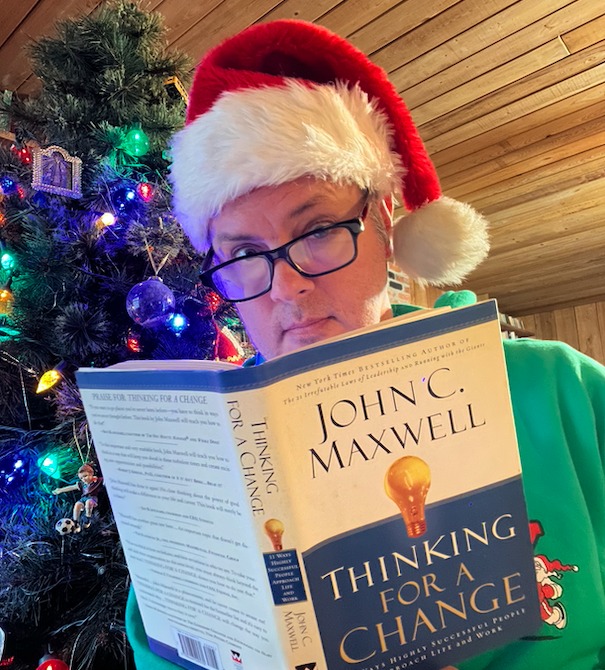
The author reading John C. Maxwell’s Thinking for a Change. Photo/Joe Domaleski
If you’re like me, then perhaps you’ve never really thought about thinking. “Thinking for a Change” was a real eye-opener for me. Embracing Maxwell’s thinking styles, from big-picture to bottom-line thinking, isn’t just about business success; it’s also about enriching every aspect of our lives. May your holidays be merry, reflective, and filled with thoughtful moments. Enjoy your holiday family time, but create some space for thoughtful, deliberate, and creative thinking. Happy New Year, everyone – let’s make it a thoughtful one!
[Joe Domaleski, a Fayette County resident for 25 years, is the owner of Country Fried Creative – an award-winning digital marketing agency located in Peachtree City. His company was the Fayette Chamber’s 2021 Small Business of the Year. Joe is a husband, father of three grown children, and proud Army veteran. He has an MBA from Georgia State University and enjoys sharing his perspectives drawing from thirty years of business leadership experience. Sign up for the Country Fried Creative newsletter to get marketing and business articles directly in your inbox. ]
by Joe Domaleski | Dec 18, 2023 | Blog, Business, Columnists, Community, Front Page, News Center, Opinion
Many of you reading this article barely made it through the year. You’re probably already seeing a lot of people posting highlight reels of the year on social media. Perhaps you’re getting another “brag letter” from a friend or family member in your Christmas card. For some, it may have been their best year ever. That’s awesome. For many others, this may have not have been their best year. If that describes you, don’t let that take away from your joy and sense of accomplishment. As they say, “comparison is the thief of joy.” You made it through a tough year and I want to acknowledge your resilience.
“Do not judge me by my success, judge me by how many times I fell down and got back up again.” – Nelson Mandela
Earlier this year, my business celebrated its 20th anniversary, an impressive milestone to be sure. Yet, it wasn’t our best year ever. For the first time in many years, our business did not grow in terms of employees or revenue. Things started to slide a little at the end of 2022. We didn’t lose money, but it wasn’t a super growth year like it’s been over the previous four years. Inflation and economic uncertainty have impacted many of our clients, some of whom are scaling back. When that happens, it impacts us. I don’t mind sharing that with you. Many people feel the need to share a false image of perpetual “I’m always winning” success online. I think it’s important to be candid here. If you’ve struggled this year, you’re not alone.
Being in business for twenty years has given me perspective. Over the course of my business career, it’s been my honor to receive many personal and organizational awards – several of which have been chronicled in this newspaper. I’m now at that stage of my life and career when the spotlight is not on me, it’s on others – mostly younger people. One of the benefits of being a previous award winner is that I get to sit on many of the selection committees that pick award recipients in our local community. We have some really impressive people in our community, fine businesses, and great non-profits. Yet, we also have many people doing great things that we never hear about – people who aren’t in the spotlight but are courageous and brave.
On a personal level, the same holds true. When I was younger, I was a fairly competitive age-group runner. Now that I’m older and dealing with arthritis, I’m not really running anymore. Although I stay fit, my best athletic days are behind me, and I live vicariously through others’ marathons, triathlons, and other athletic accomplishments. I have gray hair, wrinkles, and have a hard time staying awake past 9:30pm at night. Not only with athletics and health, but this is the same with life achievements. It’s fun to see my (now adult) children and many of the children of my friends graduate college, get married, have babies, and achieve other life milestones. Yet, for every winner and accomplishment, there are hundreds of others who aren’t publicly recognized. Their achievement is just making it – paying down student debt, handling setbacks, or just paying the bills. Sometimes I think it’s harder to “just get by” than it is to win something or achieve some life milestone. Just surviving is underrated.
Make no mistake, competition is part of life. I don’t advocate “dumbing down” standards so that everyone is a winner. But what I do know is that life has its ups and downs. Some winners don’t have to work as hard as those who are just making ends meet. Winning doesn’t last forever, but neither does losing. Our society likes to celebrate champions, money, and “famous people.” But there’s more to life than money and fame. Personally, I’m more inspired by people who overcome adversity and display resilience.
A friend of mine posted this recently online:
“I don’t think anyone really understands how tiring it is to act okay and always be the ‘strong’ one when in reality you’re close to the edge.” – Anonymous
I see you out there, survivors! You’re not alone. Here are some thoughts about what helps me get through tough times:

This is more realistic social media picture than most. #gowiththeflow Photo/TikTok
Finding my tribe – Both personally and professionally, the camaraderie of friends and family has been a lifeline. My tribe gives me perspective, a much-needed break from the “front lines,” and allows me to be who I want to be in a non-competitive way.
Celebrating small wins – This year, success was measured in modest terms. Sometimes, it was as simple as getting a new client, helping an organization meet their fundraising goal, helping a neighbor, or just waking up early to exercise. These small wins were important steps towards larger goals.
Adapting to change – If there’s one thing this year has taught me, it’s the importance of being adaptable. Artificial intelligence (AI), inflation, changing customer sentiment, and other life complexities have made even the simple stuff seem hard at times. Being agile and not stuck in the past is important. Long-time relationships change and evolve over time.
Having a positive attitude – I’ve been around long enough to know that nothing lasts forever and that many things are simply beyond my control. Truth is, you can do everything right and still not get the outcome you want. A positive attitude creates hope and encouragement for me, my team, my customers, and my family.
Being resilient – Resilience is the quiet strength that kept me going when times got tough, easy things became hard, and plans didn’t go the way I thought. Resilience (and perhaps some stubbornness) is what made me adapt, pivot, and find new ways to run the business and participate in the local community.
As we close this year and prepare for the next, I want to congratulate those of you who just barely made it. I see you and appreciate you. Remember, every challenge overcome is a testament to your strength and determination. Whether you’ve achieved great milestones or simply managed to get through each day, your journey is worthy of celebration. Here’s to you, who persisted despite the odds, who found joy in the small victories, and who continue to do the right thing, because it is the right thing to do.
To you, who made it through – congratulations! You’re a winner in my book.
[Joe Domaleski, a Fayette County resident for 25 years, is the owner of Country Fried Creative – an award-winning digital marketing agency located in Peachtree City. His company was the Fayette Chamber’s 2021 Small Business of the Year. Joe is a husband, father of three grown children, and proud Army veteran. He has an MBA from Georgia State University and enjoys sharing his perspectives drawing from thirty years of business leadership experience. Sign up for the Country Fried Creative newsletter to get marketing and business articles directly in your inbox. ]
by Joe Domaleski | Dec 11, 2023 | Blog, Business, Columnists, Community, Front Page, News Center, Opinion
As the year draws to a close, I find myself reflecting on this past year while contemplating the new year. Needless to say, a lot has happened this past year, personally and professionally. I’m willing to bet you’ve had a year of ups and downs as well. Life is never a flat road or a straight path. None of us has a crystal ball into the future, and yet, it’s natural to make life adjustments based on how things have been going and where you think things are heading.
Making easy decisions or adjustments are, by definition, “easy to make.” Making an easy decision doesn’t mean it’s easy to stick with that decision. But making the decision itself is usually not difficult. It’s human nature to gravitate towards pleasant things and avoid difficult things. Since these types of decisions are “no-brainers,” let’s consider difficult decisions.
“In any moment of decision, the best thing you can do is the right thing, the next best thing is the wrong thing, and the worst thing you can do is nothing.”
– President theodore roosevelt
Every year around this time, I spend some time in introspection. Invariably, I find myself contemplating the challenging decisions I’ve faced as a small business owner. The decision to start my business over 20 years ago was a tough decision, and I’ve been making tough decisions ever since. Besides the decision to launch the business, some of the other tough decisions I’ve made over the years include:
- Hiring people – since we’re a small business, a lot of time and consideration goes into each and every hire we make. We’ve worked really hard to hire local people and create local jobs, which is not the norm in our industry with cheap overseas and online contracted service providers.
- Parting ways with people – sometimes it “just doesn’t work out.” I like to think that all situations are fixable, but sometimes that means ending things for the betterment of both parties.
- Deciding what types of services to offer – do we play to our strengths or stretch and explore new opportunities? Our industry of digital marketing, like many, is constantly changing. Digital marketing didn’t even exist when I was in college, yet here I am doing it. What’s the future for our industry?
- Investing in new systems and technology – we aim to have the best tools for our company, but those investments are rarely quick to implement or cheap in price.
- How long to wait for a result – when we make a change or investment, it’s easy to get impatient about results. Knowing when to double down and stick with it or cut any losses is tough. I generally adhere to a 90-day rule.
- Taking on and keeping clients – we’re not a fit for everyone, nor is every client a good match for us. It’s not always easy to know how well something is going to work at the beginning. If things get bumpy, do we keep the client and try to work it out?
- Setting prices – that’s always a tough one. We are well aware of national and local “market rates” for our services. How do we handle the client who needs our help but can’t afford it? Equally as hard is the problem of not charging enough for the client who is “needy”?
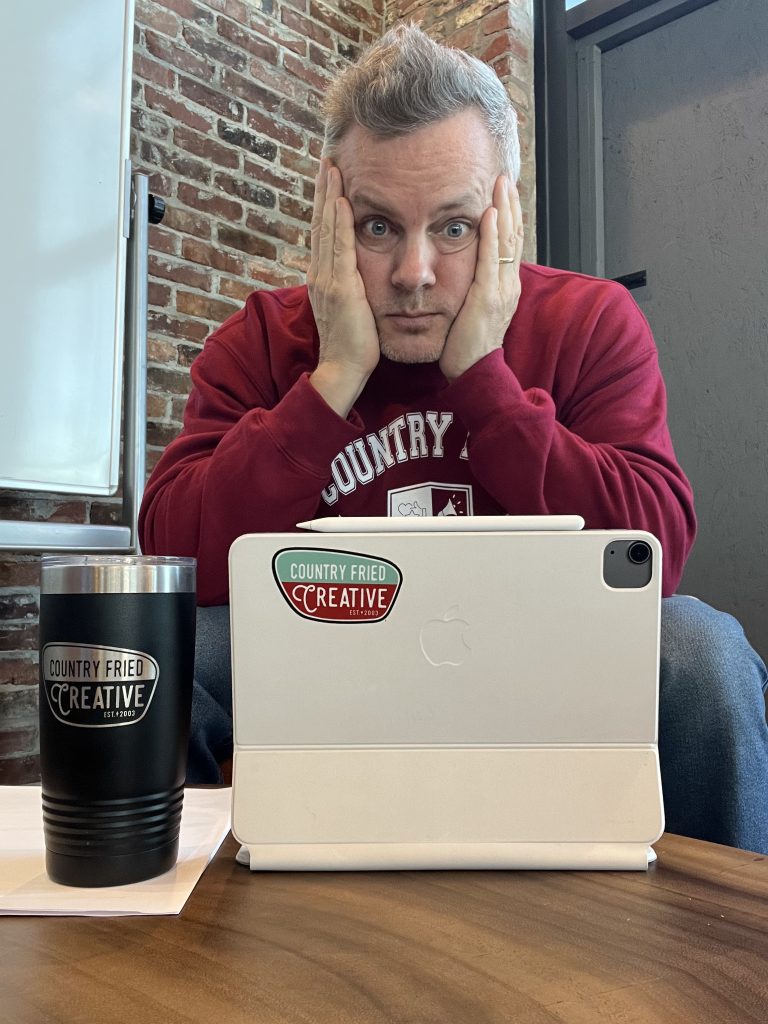
The struggle is real. The author contemplates making a tough decision. Photo/Joe Domaleski
Here’s how I handle tough decision-making, and perhaps sharing this will help you as you consider tough decisions.
Embrace the Uncertainty – One of the first things to acknowledge is that uncertainty is a natural part of decision-making. It’s rare to have all the information you need to feel 100% confident. Accepting that some level of uncertainty is inevitable can be liberating and can help you move forward.
Gather Information – Start by gathering as much relevant information as possible. In business, this could mean analyzing market trends, financial reports, or customer feedback. In personal decisions, it might involve researching, seeking expert opinions, or reflecting on past experiences. Remember, information is power, but also know when you have enough to make a decision.
Consider Different Perspectives – It’s easy to get tunnel vision, especially when you’re deeply involved in the situation. Try to view the problem from different angles. Discussing the issue with trusted colleagues, mentors, or friends can provide new insights and reveal blind spots in your thinking.
Evaluate the Risks and Rewards – Every decision has its risks and rewards. Weighing these against each other is crucial. What are the potential benefits of each option? What are the consequences? How does each scenario align with your long-term goals, both professionally and personally?
Listen to Your Intuition – While logic and data are essential, don’t underestimate the power of your intuition. Sometimes, your gut feeling can guide you towards a decision that makes the most sense for you personally or for your business, even if it’s not immediately apparent on paper.
Prepare for the Fallout – Understand that every decision, especially the tough ones, will have consequences. Prepare yourself for them. If it’s a business decision, have a contingency plan. If it’s personal, ensure you have a support system in place.
Commit and Reflect – Once you’ve made your decision, commit to it fully. Second-guessing yourself can lead to unnecessary stress and confusion. Reflect on the outcomes of your decision, learn from them, and use these insights for future decisions.
Give Yourself Grace – Finally, and most importantly, remember that it’s okay to make mistakes. No one makes the right decision every time. What’s important is that you learn from your experiences and grow both as a business owner and an individual.
As we wrap up the year, it’s important to remember that our journey is shaped by the decisions we make, both easy and challenging. The experiences of the past, with their mix of triumphs and trials, serve as important lessons as we navigate the future. Whether in our personal lives or in our business lives, each decision carves out a path for new opportunities and growth. I hope that the insights shared here not only resonate with your own experiences but also inspire confidence in your decision-making. Whatever decisions you may be struggling with, I hope you give yourself the strength to follow through and the grace to accept what life has to offer. Here’s to a year ahead filled with thoughtful choices, continued learning, and boundless possibilities.
[Joe Domaleski, a Fayette County resident for 25 years, is the owner of Country Fried Creative – an award-winning digital marketing agency located in Peachtree City. His company was the Fayette Chamber’s 2021 Small Business of the Year. Joe is a husband, father of three grown children, and proud Army veteran. He has an MBA from Georgia State University and enjoys sharing his perspectives drawing from thirty years of business leadership experience. Sign up for the Country Fried Creative newsletter to get marketing and business articles directly in your inbox. ]








